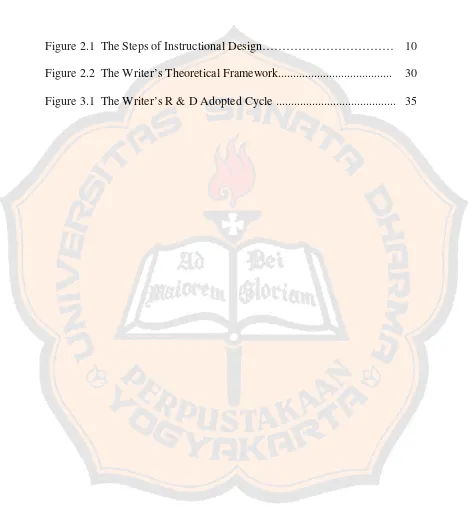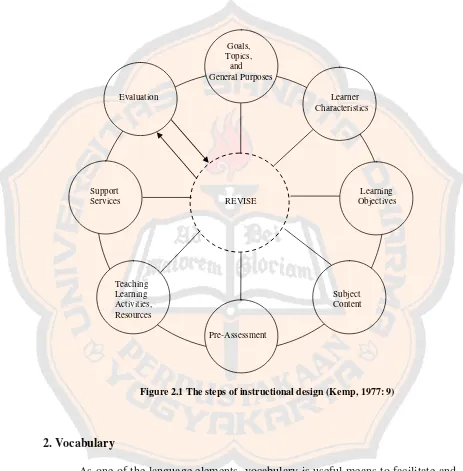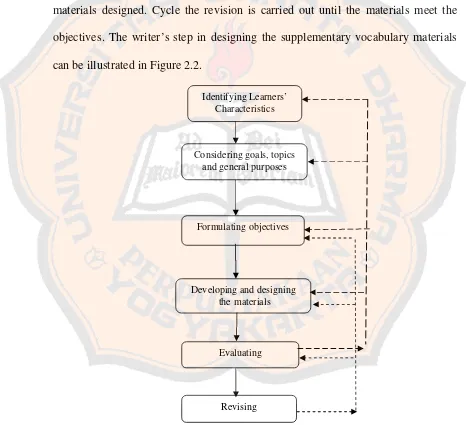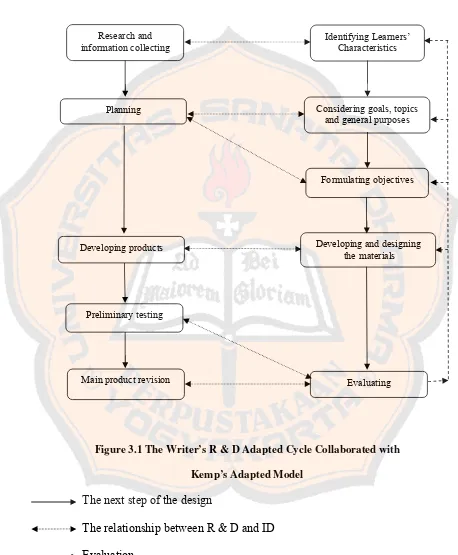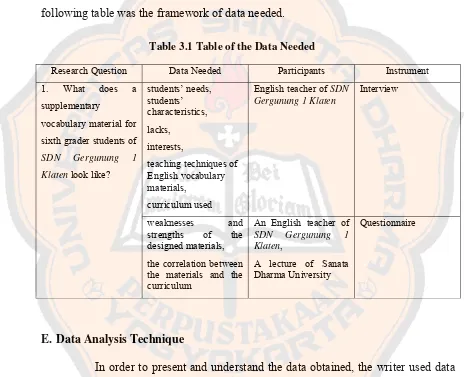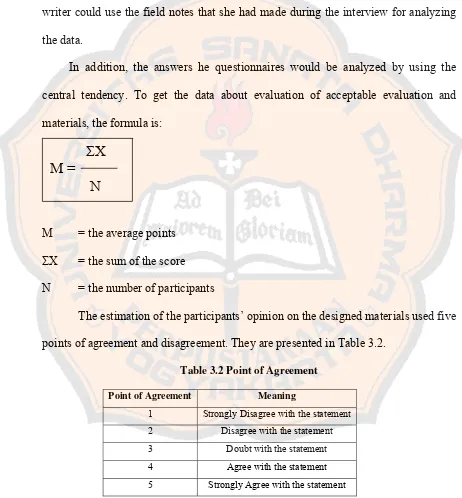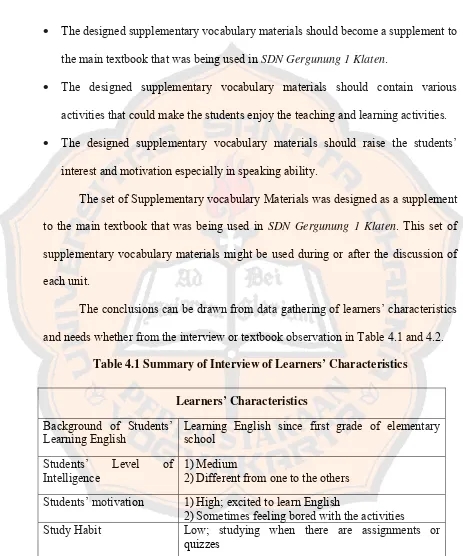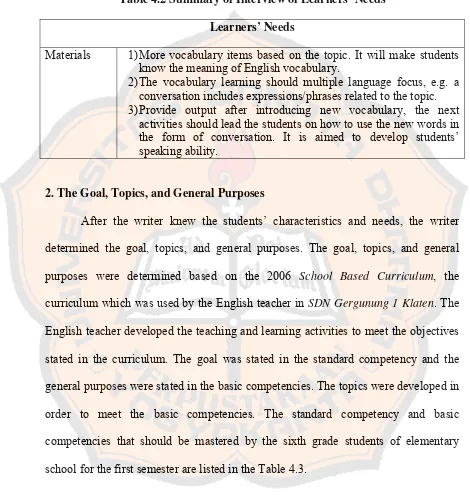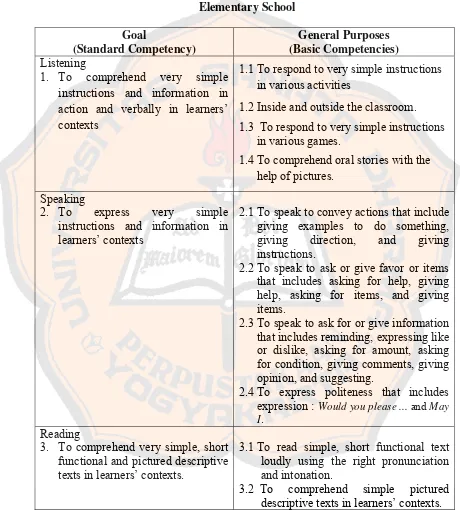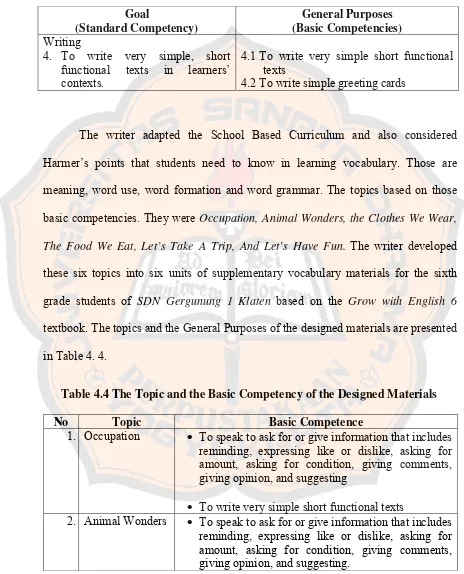DESIGNING A SET OF SUPPLEMENTARY VOCABULARY MATERIALS FOR THE SIXTH GRADE STUDENTS
OF SDN GERGUNUNG 1 KLATEN
A THESIS
Presented as the Partial Fulfillment of the Requirements to Obtain the Sarjana Pendidikan Degree
in English Language Education
By:
By Cahyarini 04 1214 003
ENGLISH LANGUAGE EDUCATION STUDY PROGRAM DEPARTMENT OF LANGUAGE AND ARTS EDUCATION FACULTY OF TEACHERS TRAINING AND EDUCATION
SANATA DHARMA UNIVERSITY YOGYAKARTA
i
DESIGNING A SET OF SUPPLEMENTARY VOCABULARY MATERIALS FOR THE SIXTH GRADE STUDENTS
OF SDN GERGUNUNG 1 KLATEN
A THESIS
Presented as the Partial Fulfillment of the Requirements to Obtain the Sarjana Pendidikan Degree
in English Language Education
By:
By Cahyarini 04 1214 003
ENGLISH LANGUAGE EDUCATION STUDY PROGRAM DEPARTMENT OF LANGUAGE AND ARTS EDUCATION FACULTY OF TEACHERS TRAINING AND EDUCATION
SANATA DHARMA UNIVERSITY YOGYAKARTA
v
STATEMENT OF WORK’S ORIGINALITY
I honestly declare that this thesis, which I have written, does not contain the work or parts of the works of other people, except those cited in the quotations and references, as a scientific paper should.
Yogyakarta, 25 July 2011 The writer,
vi ABSTRACT
Cahyarini. 2011. Designing a Set of Supplementary Vocabulary Materials for the Sixth Grade Students of SDN Gergunung 1 Klaten. Yogyakarta: Sanata Dharma University.
English is the first foreign language in Indonesia that has been taught at elementary school starting from the fourth grade as one of the local content. There are four English skills that should be accomplished. Vocabulary is considered as an important language element, whereas, in School Based Curriculum only stated four skills. Regarding the importance of vocabulary mastery, the study was intended to design a set of supplementary vocabulary materials for the sixth grade students of SDN Gergunung 1Klaten.
This study discussed a problem. It was formulated in the research question: What does a set of supplementary vocabulary materials for the sixth grade students of elementary school of SDN Gergunung 1Klaten look like?
This study was done by conducting the steps’ of Kemp’s instructional design model which was put under the umbrella of Borg and Gall’s R&D cycle. This study also considered relevant theories related to vocabulary and Communicative Language Teaching.
To answer the question, the writer presented the final version of the designed materials. It consisted of six material units. Each unit consisted of four main sections, namely a) My New Words, b) Let’s Write, c) Let’s Speak and d) My Playground . Most of the acivities in each part were dominated by vocabulary teaching and learning.
The materials evaluation results showed that the mean was 4.71 ranging from 3.51 – 5.00. It showed that the designed materials were well developed, well elaborated, motivating, and applicable for the sixth grade of SDN Gergunung 1 Klaten.
vii ABSTRAK
Cahyarini. 2011. Designing a Set of Supplementary Vocabulary Materials for the Sixth Grade Students of SDN Gergunung 1 Klaten. Yoghyakarta: Universitas Sanata Dharma.
Bahasa Inggris andalah bahasa asing utama di Indonesia yang telah di ajarkan sejak di sekolah dasar mulai dari kelas empat sebagai salah satu pelajaran wajib. Ada empat kemampuan dasar yang harus dicapai dalam pembelajaran bahasa Inggris. Vocabulary dianggap sebagai sebuah elemen bahasa terpenting padahal di dalam Kurikulum Tingkat Satuan Pendidikan hanya terdapat empat kemampuan dasar berbahasa Inggris. Berdasarkan pentingnya menguasai vocabulary, penelitian ini ditujukan untuk merancang satu set materi pelengkap vocabulary untuk siswa kelas enam SDN Gergunung 1Klaten.
Penelitian ini membahas satu masalah. Ini di rumuskan dalam pertanyaan penelitian: Seperti apakah penyajian materi pelengkap pembelajaran vocabulary untuk siswa kelas enam SDN Gergunung 1Klaten.
Penelitian ini dilaksanakan dengan menerapkan enam langkah yang diadaptasi dari model instruksional Kemp. Langkah- langkah tersebut adalah yang diletakkan di bawah kerangka metode Borg dan Gall’s R&D rangka. Penelitian ini juga mempertimbangkan teori berhubungan dengan vocabulary dan Communicative Language Teaching.
Untuk menjawab pertanyaan, penulis menyajikan materi pelengkap pembelajaran vocabulary bahasa Inggris. Materi pelengkap ini terdiri dari enam unit materi. Setiap unit terdiri dari empat bagian, yaitu a) My New Words, b) Let’s Write, c) Let’s Speak and d) My Playground. Setiap kegiatan dari tiap bagian didominasi oleh pengajaran dan pembelajaran vocabulary.
Hasil dari penyusunan materi memperlihatkan bahwa nilai rata- rata adalah 4.17 berkisar dari 3.51 – 5.00. ini memeperlihatkan bahwa material dikembangkan dengan baik, digabungkan dengan baik, , memotivasi, dan dapat diterapkan kepada siswa- siswa kelas enam SDN Gergunung 1Klaten.
viii
LEMBAR PERNYATAN PERSETUJUAN
PUBLIKASI ILMIAH UNTUK KEPENTINGAN AKADEMIS
Yang bertanda tangan di bawah ini, saya mahasiswa Universitas Sanata Dharma: Nama : Cahyarini
Nomor Mahasiswa : 041214003
Demi pengembangan ilmu pengetahuan, saya memberikan kepada Perpustakaan Universitas Sanata Dharma karya ilmiah saya yang berjudul:
DESIGNING A SET OF SUPPLEMENTARY VOCABULARY MATERIALS FOR THE SIXTH GRADE STUDENTS OF SDN GERGUNUNG 1 KLATEN Beserta perangkatnya (bila ada). Dengan demikian saya memberikan kepada Universitas Sanata Dharma hak untuk menyimpan, mengalihkan dalam bentuk media lain, mengelolanya dalam bentuk pangkalan data, mendistribusikan secara terbatas, dan mempublikasikanny di internet atau media lain untuk kepentingan akademis tanpa perlu meminta ijin dari saya maupun memberikan royalti kepada saya selama tetap mencantumkan nama saya sebagai penulis.
Demikian pernyataan ini saya buat dengan sebenarnya. Dibuat di Yogyakarta
Pada tanggal: 29 Juli 2011
Yang menyatakan,
ix
ACKNOWLEDGMENTS
First of all, I would like to give my greatest gratitude to Jesus Christ for His guidance, blessing and strength, especially during the writing process of my thesis. I do believe that what I have done is a part of His beautiful plan for my future. I would like to thank my beloved sponsor Gregorius Punto Aji, S.Pd., M.Hum. who has spent a lot of time guiding and supervising me in the completion of this thesis. Besides, his encouragement during the process of the thesis writing was great motivation for me.
I would like to thank to Drs. Y. B. Gunawan, M. A. For his time to evaluate the materials. Without his suggestions and opinions, I could not make better materials.
I am particularly grateful to SDN Gergunung 1 Klaten, as an educational institution, which has given the permission to use the students as the research subjects. Especially to Drs. Sutarno Bambang Purnomo, the English teacher, I thank him for spent his valuable time for helping me with this research.
My special gratitude also goes to my dearest mother, my dearest father, my brother and my sisters, who always support and give me spirit to finish my study. I might give up without them. I give my gratitude to my boyfriend ‘ Ari Sandy Prasetya’, who always supports me to finish my thesis soon.
x
The last but not least, I thank all of my friends in PBI, whom I have not able to mention here, for their concern.
xi
TABLE OF CONTENTS
page
TITLE PAGE . ……… i
APPROVAL PAGES ……… ... ……..………. ….. ii
DEDICATION PAGE……… iv
STATEMENT OF WORK’S ORIGINALITY ……… v
ABSTRACT ……… vi
ABSTRAK ……… vii
PUBLICATION PAGE ………... viii
ACKNOWLEDGEMENTS ……… ix
TABLE OF CONTENTS ……… xi
LIST OF TABLES ……… xv
LIST OF FIGURES ………. ……… xvi
LIST OF APPENDICES ………. xvii
CHAPTER I: INTRODUCTION ……….... 1
A. Research Background ………... 1
B. Problem Formulation ……….. 3
C. Problem Limitation ………. 4
D. Research Objectives ……….... 4
E. Research Benefits ……… 4
xii
CHAPTER II: LITERATURE REVIEW ……….………. 7
A. Theoretical Description ……… 7
1. Kemp’s Instructional Design ……….……….. 7
2. Vocabulary……… 10
a. The Nature of Vocabulary ……….. 11
b. Teaching Vocabulary ………... 12
3. Communicative Language Teaching………... 15
a. The Nature of Communicative Language Teaching ……….. 16
b. The Goal of Communicative Language Teaching.. ………… 17
c. The Type of Communicative Language Teaching…………. 17
4. School-based Curriculum 2006……… 19
5. Learners’ Characteristics ………. 21
a. Critical Period Hypothesis………. 22
b. How Children Learn ………... 23
c. Elementary School Students ……… 24
B. Theoretical Framework ……… 25
1. Identifying Learners’ Characteristics ……… 25
2. Considering Goals, Topics, and General Purposes ………. 26
3. Formulating Objectives ………. 27
4. Designing and Developing Materials ……… 27
5. Evaluation ……….. 28
xiii
CHAPTER III: RESEARCH METHODOLOGY ……….. 30
A. Research Method ………. 30
1. Research and Information Collecting………..………... 31
2. Planning………… ………. 31
3. Developing Preliminary Form of Product………. 32
4. Preliminary Field Testing………. 32
5. Main Product Revision……… 33
B. Research Participants.….………... 35
C. Research Instruments…. ………. 36
D. Data Gathering Technique………..……… 38
E. Data Analysis Technique……… 39
F. Research Procedure…. ……….. 41
CHAPTER IV: RESEARCH RESULTS AND DISCUSSION ………….. 43
The Elaboration of Steps in Designing Materials……….. 43
1. Learners’ Characteristics and Needs ………. 44
2. The Goals, Topics and Purposes ………. 48
3. Learning Objectives…….……… 51
4. The Supplementary Vocabulary Materials ………. 53
a. Subject Content……….. 53
b. Teaching Learning Process……….. 55
xiv
6. Preliminary Testing ……… 61
CHAPTER V: CONCLUSION AND SUGGESTIONS ………... 66
A. Conclusion ………..… 66
B. Suggestions ……….…… 68
REFERENCES ……….. 69
xv
LIST OF TABLES
Table 3.1 Table of the Data Needed ………... 40 Table3.2 Point of Agreement……….……… 41 Table 4.1 Summary of Interview of Learners’ Characteristics……….. 48 Table 4.2 Summary of Interview of Learners’ Needs ……….. 48 Table 4.3 Competency Standards and Basic Competencies of the
Sixth Grade Students of Elementary School ….……… 49 Table 4.4 The Topic and the Basic Competency of the Designed
Materials ……… 51
Table 4.5 The Learning Indicators in Each Topic ………. 52 Table 4.6 The Organization of Subject Contents ….………. 53 Table 4.7 List of the Topics, Vocabularies and Expressions …………. 55 Table 4.8 The Teaching and Learning Activities ………. 58 Table 4.9 The Description of the Respondents of the Preliminary
Field Testing……….. 61 Table 4.10 The Results of the Preliminary Field Testing
xvi LIST OF FIGURES
xvii
LIST OF APPENDICES
Appendix 1: Letters to the Headmaster of SDN Gergunung 1 ………… ... 74
Appendix 2: Instruments ... 75
2.1List of Questions for Interviewing the Teachers ……….. 76
2.2Raw Data of the Result of Interview………. 78
2.3Questionnaire for Preliminary Field Testing……… 81
Appendix 3: Syllabus and Lesson Plan ... 84
3.1Syllabus ... 85
3.2Lesson Plan ... 91
Appendix 4: Designed Materials ... 99
1 CHAPTER I INTRODUCTION
In this chapter, the writer presents six major underlying issues. They are research background, problem formulation, problem limitation, research objectives, research benefits, and definition of terms. Therefore, the introduction is intended to provide and describe the research background information.
A. Research Background
As a means of communication, language is important in our life. There are so many languages in this world, and one of the most important languages is English. Considering the importance of English as an international language, Indonesian government has instructed it to be introduced and taught as one of the compulsory subjects in elementary school.
To give guideline to all elementary schools that teach English, the government has established the 2006 School Based Curriculum. The curriculum emphasizes the acquisition of the four English skills namely listening, reading, writing, and speaking, and on the usage of English in various contexts. Language elements should not be taught individually and must be in accordance to the acquisition of four language skills. The teaching of vocabulary that becomes the basic language element to master four language skills must be integrated in the teaching of four language skills.
Unfortunately, since vocabulary does not become an objective anymore, many teachers neglect the importance of vocabulary mastery. Some teachers omit vocabulary teaching from their teaching and learning activities. Some teachers do not try to teach vocabulary interestingly so that many students become uninterested in learning vocabulary.
Though vocabulary is neglected in the English teaching and learning, it significantly influences the development of communicative competence and the acquisition of the four language skills because vocabulary gives elementary school students basic knowledge to comprehend, write, and speak in English. Thus, it is important to teach vocabulary appropriately.
Because of the above reasons, the writer is interested in conducting a study on designing a set of supplementary vocabulary materials for the sixth grade students of SDN Gergunung 1Klaten. The writer will use Communicative Language Teaching as a basic approach to design the materials in order to show the students the right context in using words.
B. Problem Formulation
This study will particularly discuss the vocabulary items presented in the textbook for the sixth grade students of SDN Gergunung 1 Klaten and then develop them into a set of supplementary materials. There is one problem to be examined in this study. This problem is as follows.
C. Problem Limitation
This study limits the discussion on English language teaching by working on instructional design area. This study is to design supplementary vocabulary materials for the sixth grade students of elementary school. It focuses on a textbook used by the teacher of the sixth grade students of SDN Gergunung 1 Klaten. The writer uses a textbook as a subject matter to identify vocabulary items and language function to develop the supplementary materials.
D. Research Objective
The objective of the study is address the problem stated in the problem formulation. It is to design the appropriate supplementary vocabulary materials for the sixth grade students of elementary school of SDN Gergunung 1Klaten.
E. Research Benefits
This study is expected to give contribution to the following people. 1. The English teacher and English teacher candidates
2. Sixth grader students of elementary school
The designed materials will help the students to have better comprehension of the textbooks. They can use the materials as basic exercises before they discuss the textbook.
F. Definition of Terms 1. Material Design
Material design is a model that provides us a coherent framework for integration of the various aspects of learning (Hutcinson and Waters, 1994: 106). In this study, materials design means any activities or data that provide suitable content for the target students so that the learning process can be well-organized and reach its aim.
2. Supplementary
Supplementary according to Echols (2000) is the adjective form of addition. The addition in this case, is vocabulary materials, which are added to the previous existing materials. In this study, supplementary materials refer to the materials of English vocabulary, which is intended to motivate the students to study in more interesting situation.
3. Vocabulary
facilitate and support the learners in learning the language skills. In this study, the vocabulary items are selected based on the existing textbook and the needs of the sixth grade elementary school students.
4. SDN Gergunung 1Klaten
Based on Peraturan Pemerintah RI No. 28, 1990(Depdikbud, 1994:1), the definition of the elementary school is a unit form of basic education, which runs a six-year education program. The sixth grade of elementary school means those who are in the sixth year or level in the elementary school. They are children from 11 to 12 years old.
In this study, the writer defines the term elementary school which consist of children in the age of 6-12 years. The sixth grade students are those who study in the last level at SDN Gergunung 1Klaten.
7 CHAPTER II LITERATURE REVIEW
This chapter is divided into two main parts, namely theoretical description and theoretical framework. In the theoretical description, the writer reviews some theories used as the references of the study. Then, the writer draws a theoretical framework based on the theoretical description which is used as the guideline to answer the problems of this study.
A. Theoretical Description
In this part, the writer discusses some theories which will be used as the guidance to the development of the supplementary vocabulary materials. They are instructional design models, vocabulary theory, Communicative Language Teaching (CLT), school- based curriculum, and learners’ characteristics.
1. Instructional Design Models.
In this section, the writer will present the three criteria as the requirement for choosing a model stated by Soekamto (1993; 11), as below:
b. A model should contain all steps that need to be implemented in the process of instructional system in order to be well functioned.
c. Moreover, if a model has prescriptive characteristic, this model should be flexible so that the adaptation between the instructional objectives and the strategy will activate the learning objectives.
In this study, the writer would consider Kemp’s instructional design model to design and develop the supplementary vocabulary materials. Kemp follows the system approach where the goal and evaluation are used for adjustment and improvement. “System approach is the overall plan of the instructional design compiled in order” (Kemp, 1977). Kemp’s model of instructional design is a flexible one. The designer can start from any steps.
Kemp (1977:8-9) states that the designer should consider three elements: objectives, activities and resources, and evaluation.
According to Kemp (1977), the instructional design plan in designed to answer three questions which may be considered as an essential instructional technology. The questions are:
1. What must we learn? (Objective)
2. What procedures and resources will work best to teach the desired learning levels? (Activities and resources)
These three elements are the basic of creating an instructional design. If one of them is missing, then the designer fails to make a good design.
Kemp’s design (1977:19-91) consists of eight parts:
Part 1 : Consider goals, and then list topics, state the general purposes for teaching each topic.
Part 2 : Identify the important characteristics of the learners for whom the instructional is designed.
Part 3 : Specify the learning objectives to be achieved in terms of measurable student behavioral outcomes.
Part 4 : List the subject content to support each objective.
Part 5 : Develop pre-assessment to determine the student’s background and present level of knowledge about the topic.
Part 6 : Select teaching/learning activities and instructional resources that will treat the subject content so learners will accomplish the objectives.
Part 7 : Coordinate such support services as budget, personnel, facilities, equipment and schedules to carry out the instructional plan.
Part 8 : Evaluate learners’ learning in terms of their accomplishment of objective, with a view to revising and reevaluating any phrases of the plan that need improvement.
ready to start with and then to move back and forth to the other steps because all parts are interrelated.
Goals, Topics, and General Purposes
Evaluation Learner
Characteristics
Support Learning
Services REVISE Objectives
Teaching
Learning Subject
Activities, Content
Resources
Pre-Assessment
Figure 2.1 The steps of instructional design (Kemp, 1977: 9)
2. Vocabulary
a. The Nature of Vocabulary
In this study, vocabulary means a number of words, which students usually find in their daily life. The stocks of words must be in everyday vocabulary of most people. Krashen and Terrel (1983) emphasizes that vocabulary is the basic to communicate and also important for the acquisition process. Therefore, learning a language cannot be separated from learning its vocabulary.
Harmer states that ‘knowing a word means far more than just understanding (one of) its meaning (s).” There are things that students need to know in learning vocabulary (1991: 156-158):
1) Meaning: students need to understand the importance of meaning in context. Sometimes words have meaning in relation to other words. Thus, students need to know the meaning of a word to describe any one of number of other things. For example ‘fruits’ has a general meaning whereas “apple, orange, grapes” are more specific.
2) Word use: students need to know that words’ means can be changed, stretched or limited by how they are used. Students need to recognize metaphorical language use and they need to know how words collocate. They also need to understand the topical contexts words and expressions occur.
their form’ (1991:157). Part of learning a language its written and spoken form. Students need to know how words are spelt and how they sound.
4) Word grammar: Students need to know how words change according to the grammatical meaning and use certain grammatical patterns.
b. Teaching Vocabulary
Words are essential to communication and vocabulary is an important factor in all language teaching. Foreign language students tent to pick up vocabulary first and then gradually develop a more accurate structural frameworks in which use these words. Students must continually be learning words as they practice the sound system. There are many preparations that should be done by teachers before teaching foreign language vocabulary. One important thing is to look up the kind of vocabulary presented in the curriculum.
Teaching vocabulary involved some steps (Lado, 1964: 121) they are: 1) The learners hear the (new) word for several times
In this step, the learners are given some (new) words for several times and let them hear it. The pronunciation of the (new) words should be clear and loud enough, so that the learners are able to hear every single word, which is pronounced.
2) The learners pronounce the word
3) The learners grasp the meaning
It is better to give the meaning of the (new) word to the learners without using the direct translation. The learners may be given the definition and pictures to describe the meaning of the word.
4) The teacher illustrative sentence
This step is done by giving several examples that illustrate the range and variation of usage.
5) The learners practice from meaning to expression
After knowing the word, the learners are asked to practice the use of the words to reinforce the trace and turn it into a habit.
6) The learners reading the word
After the class have heard and pronounced the word and know what it means, they should see it and read it aloud. Writing the word will also help the learners to remember the spelling of the word
Traditionally, vocabulary learning is taught through a series of drills and repetition. However, drills and repetition are unlikely to be motivating since they are monotonous which lead into boredom. Furthermore, something memorized will not easily appear when needed.
In facts, other techniques generally involve the learner more, and they remember better. There are some examples of different ways of presenting vocabulary items Devies (2000) and Siwi Karmadi Kurniasih (1999: 19-20). They are as follows:
1) Through real object: The teacher may use the real objects or realia to present some vocabulary. By seeing the object directly, the student will understand deeply. 2)Through picture: sometimes the teacher cannot bring the real object inside the
class. To overcome this, pictures can be used.
3)Through example: the students in the sixth grade of elementary school have already been able to give example. The teacher can explain some vocabulary by giving the example to the students.
4)Definition: for the upper learner, the teacher can use definition in the target language to give the meaning to the learner.
5)Demonstration: this way of presenting a new vocabulary is especially useful for presenting the concrete vocabulary of beginner’s and elementary students
6)Translation: translation is a best used as a last resort. It is also best, when possible, to elicit the translation to the learner. Involving the learner activity can motivate and help them remember the items.
8)Antonyms or synonym: using contrast or antonym is another technique for example; we present the meaning of ‘cold’ by contrasting with ‘hot’. The opposite of using antonym is using equivalence, or synonym, for example ‘they are having a chat-conversation’.
9)Story: the student will know to use the vocabulary in context. However, the teacher has to be really careful in selecting the story, so it will not burden the students. 10)Songs: the atmosphere of the class would be full of joy by introducing songs in
the class. The songs make the students relax and enjoy the learning process.
11)Games: games will be appropriate in teaching children. The nature of children is attractive, enthusiastic and full of energy.
The writer combines all the explanation on the nature of vocabulary and teaching vocabulary to make the supplementary vocabulary material. Those theories above are used by the writer to create the most effective teaching and learning activities when it is applied in the classroom. Moreover, by following the theories, the writer wishes to complete the objectives of the lesson and also to encourage the students’ motivation.
3. Communicative Language Teaching (CLT)
would cover some discussion on the nature of CLT, goal of CLT and type of activities in CLT.
a. The Nature of Communicative Language Teaching
Basically, there are lots of definitions of CLT proposed by scientists in this last decade. Therefore, the writer would like to take some definitions that are suitable and clear enough to be understood by both the writer and the readers. According to Richards (2005: 2), CLT can be understood as a set of principles about the goal of language teaching, how learners learn the language, the kinds of activities that best facilitate learning, and the rules of teachers and learners in the classroom that all of them set the goals to the communicative competence. Meanwhile, Martalinova (2006: 37) defines CLT as an approach to the second and foreign language teaching that involves more than simply learning grammatical pattern and rules. It gives the students changes to improve their ability to communicate in target language.
develop procedure for the teaching of four language skills that acknowledge the independence of language and communication.
b. The Goal of Communicative Language Teaching
Communicative language teaching has its goal of communicative competence. Therefore, all of the activities in the classroom conducted by the teacher should be aimed to achieve the communicative competence that can be applied by the students in the real communication. Richards (2005:2) also writes the aspects of language knowledge included in the communicative competence. Those aspects were elaborated as follows:
1) To know how to use language for a range of different purposes and functions. 2) To know how to vary our use of language according to the setting and the
participants (e.g. knowing to use formal and informal speech or when to use language appropriately for written as opposed to spoken communication).
3) To know to produce and understand different types of texts (e.g. narratives, reports, interviews and conversations).
4) To know how to maintain communication despite having limitations in one’s language knowledge (e.g. through using different kinds of communication strategies)
c. Type of Activities in Communicative Language Teaching
1) Task-complete activities: puzzle, games, map-reading, and other kinds of classrooms task in which the focus was on using one’s language resources to complete a task.
2) Information gathering activities: students conducted surveys, interviews and searches in which the students were required to use their linguistic resources to collect information.
3) Opinion-sharing activities: activities where students compare values, opinions, beliefs, such as a ranking task in which students list six qualities in order of importance which they might consider in choosing their date or spouses.
4) Information-transfer activities: these require learners to take information that is presented in one form, and represent it in different form. For example, they may read instructions on how to achieve from A to B, and then draw a showing the sequence or they may read the information about a subject and then represent it as a graft.
5) Reasoning- gab activities: these involve deriving some new information from given information through the process of inference, practical reasoning, etc. for example, working out teacher’s timetable on the basis of class given timetable. 6) Role-play activities: activities in which students are assigned roles and improvise
scene or exchange based on given information or clues.
activities in CLT are conducted in pairs or in a small group. Therefore, there are a lot of benefits that will be obtained by the students. The students can learn from words used by other members of the group. The students can also produce a greater amount of language than they would use in the teacher-fronted activities. Their motivational level is likely to increase because the activities can encourage the students not to be bored. The last benefit is the students will have the chance to develop their fluency. Hence, CLT is the most suitable method that matches the ideal principle of vocabulary teaching.
Those theories above were used in order to achieve the most effective teaching and learning activities when designed materials are applied in the classroom.
4. The 2006 School Based Curriculum
interest. The curriculum were developed in accordance with the national standard of education which includes Content Standard (Peraturan Menteri No.22) and Graduates’ Competency Standards (Peraturan Menteri No.23). The Content Standard involves basic framework, curriculum structure, learning content, and academic calendar while Graduates’ Competency Standard involves the minimum graduates’ competency standards of subject matters.
The School-based Curriculum also states that learning English for elementary school is aimed at attaining functional level. It is the level of which the students should be able to interpret others’ conversation, express feelings, comprehend reading text and write simple sentences in any topics, to be aware that English is important in globalization era and to develop their understanding about the relationship between language and culture. (School-based Curriculum, 2006: 277-278).
It is also included that the teaching of English covers four skills namely Listening, Speaking, Reading and Writing and four different features of language; discourse, vocabulary, grammar and pronunciation. In this study, the writer focuses on vocabulary teaching. However, the supplementary vocabulary English materials taught in classroom should deal with the competency standards and the basic competences stated in the school-based curriculum.
and the basic competence that later become the guideline to make the indicators and materials.
5. Learners’ Characteristics
It is not easy to teach foreign language to children. A good teacher has to know the characteristic of the learners well. This section will discuss the critical period hypothesis, how children learn, and learners’ characteristic of the sixth grade elementary school students.
a. Critical Period Hypothesis
The concept of a critical period in animal behavior was applied to language acquisition by Penfield and Roberts (1959). They emphasized also that it is very difficult to learn a second language after puberty.
Lenneberg proposed brain lateralization at puberty as the mechanism that closed down the brain’s ability to acquire language. He stated that the crucial period of language acquisition ends around the age of 12. Penfield and Robert (1959) and Lenneberg (1967) produced evidence to show that the two halves of the brain (the left and right hemispheres) become specialized for different functions around puberty, they argued, a critical period exists during which the brain is more plastic and allows, among other things, the transfer of a function from one hemisphere to the other when the former has been injured and for new patterns of behavior to be efficiently processed.
In second language acquisition, the strongest evidence for critical period hypothesis is in the study of accent, where most older learners are unlikely to reach a native- like level. While the window for learning a second language never completely closes, certain linguistic aspects appear to be more affected by the age of the learner than others. For example, adult second- language learners nearly always retain an immediately – identifiable foreign accent, including some who display perfect grammar (Oyama, 1976).
type of learning. David Singleton (1995) states that in learning a second language, “younger=better in long run”.
b. How Children Learn
Learning for children is development that comes from exercise and effort. Some learning comes from practice the mere repetition of an act. they bring about a change in the persons behavior. Elisabeth B. Hurlock in her book “Child Development” (1978:155) states that some learning may consist of imitation, in which the child consciously copies what he sees others do. Or it may consist of identification, in which he attempts to adopt as his own values, attitudes, motives, and behavior to whom he admires or loves. Moreover she says that in learning to pronounce words, it comes from imitating others.
According to Jeremy Harmer (2001:38), children learn differently from older children, adolescence, and adults in the following ways:
1) They respond to meaning even if they do not understand individual words.
2) They often learn indirectly rather than directly- that is they take information from all side, learning from everything around them rather than only focusing on the precise topic they are being taught.
3) Their understanding comes not just from explanation, but also from what they see and hear and, crucially, have a change to touch and interact with.
5) They have a need for individual attention and approval from the teacher.
6) They are keen to talk about themselves, and respond well to learning that uses themselves and their on lives as main topics in the classroom.
7) They have a limited attention span; unless activities are extremely engaging they can get bored, losing interest after ten minutes or so.
c. Elementary School Students
Elementary school children in general are in the period of life from age 6-12 or more. The period has been given a number of labels. One of them is school years, that is to point out that a child is now capable of a kind of systematic learning more or less related to what goes on in schools. (Joseph, 1968: 345)
The elementary school in this study is a public school, which consists of children in age of 6 to 12 years old. The sixth grade students are those who study in the last level at SDN Gergunung 1Klaten.
B. Theoretical Framework
This theoretical framework consists of the steps for developing and designing the supplementary vocabulary materials by adapting Kemp’s instructional design model and by considering the theory of teaching vocabulary, theory of Communicative Language Teaching, learners’ characteristics, and School-based Curriculum. Kemp’s model is chosen because it is flexible. We can start and go forward from whichever element we are ready to start with and then move to the other steps. The steps are presented as follows.
1. Identifying Learners’ Characteristics
Knowing the learners’ characteristics is useful in order to provide us with a foundation of learners’ information upon which the educational product is designed. In addition, learners’ characteristics are used as the input and basis for the writer in designing the materials. It will be useful for determining the materials, the learning tasks and activities, and the techniques or strategies conducted in classroom.
interested in learning all kinds of things and they want to know as many facts as possible about many different things. Those theories are important to consider because knowing the students’ characteristic is essential for it can affect the designed materials especially for deciding the materials used, the tasks given and the techniques or methods applied in classroom.
In this study, identifying learners’ characteristics includes information the learners’ capabilities, needs and interests. The writer also notes the learners’ academic, social and emotional factors such as academic background, learners’ participation in class, level of intelligence, relations among others and study habits. The result of this study was used as a guideline to design the materials.
2. Considering Goals, Topics and General Purposes
The next step is taken from stating goals, topics, and general purposes Kemp’s step. Learning goals are something that the students should achieve in their learning process. In choosing the goal for the teaching learning process in this study, the writer considered the point that students need to know in learning vocabulary (Harmer, 1991:156). At least three of four points: meaning, word use and word formation.
instruction. In this study, the writer will list some topics based on the general purposes as in School-based Curriculum stated as Basic Competences.
3. Formulating Objectives
After having known and understood the goals, the objectives must be stated in terms of activities that will best promote learning. Learning objectives are more specific than learning goals which concern with learning as the outcome of instruction. The learning objectives of the designed supplementary vocabulary materials expect the students to be able to master vocabulary given and apply it using the target language accurately, fluently, and in acceptable way based on the topics. 4. Designing and Developing Materials
The activities included in subject content, learning activities and resources and supporting services steps are selecting material and media and determining the learning tasks and strategies.
a. Selecting materials and media
communicative English books such as Heinemann Children’s Games and Elementary Communication Games as references to create classroom activities. The media used in the class should help the students to process information in the mastering vocabulary and enable the students to enhance better learning.
b. Determining learning tasks and strategies
As the materials have been selected, the writer then determines the learning tasks and strategies. It is stated before that for determining the learning tasks, the ways children learn and the learners’ characteristic in imitating should be considered. Therefore, the learning tasks should lead the students to be accustomed to hear (new) words and understand the meaning of the (new) word.
It is paramount for a successful teaching-learning process to select or to organize the learners’ learning activities and instructional materials. A well-designed material can support the learners’ mastery of the English ability and can achieve vocabulary mastery for sixth grade students of elementary school.
5. Evaluating
Identifying Learners’ Characteristics
Considering goals, topics and general purposes
Developing and designing thematerials
Revising
writer can get feedbacks to the materials, whether the materials meet the objectives or not.
6. Revising
The writer conducted the revision on the designed materials after gaining feedback. It is supported by Kemp who states that revision is used to improve the materials designed. Cycle the revision is carried out until the materials meet the objectives. The writer’s step in designing the supplementary vocabulary materials can be illustrated in Figure 2.2.
Figure 2.2 The Writer’s Theoretical Framework Formulating objectives
30
CHAPTER III METHODOLOGY
Based on the aims, in this chapter the writer explains the process of the
study including research method, research participants, research instruments, data
gathering technique, data analysis technique, and research procedure.
A.Research Method
It has been stated that this study aimed to answer the research question. It
was what the design of supplementary vocabulary material for sixth grade students of
SDN Gergunung 1Klaten look like.
In order to solve the problem, the writer needed to employ a method. The
method was called educational research and development (R & D). Borg and Gall
(1983), said that it is a process used to develop and validate educational products. In
this study, the products meant as the design of appropriate materials and teaching
techniques for the target students.
There are ten major steps in the R & D cycle; they are Research and
Information Collecting, Planning, Developing Preliminary Form of Product,
Preliminary Field Testing, Main Product Revision, Main Field Testing, Operational
Product Revision, Operational Field Testing, Final Product Revision and
Dissemination and Implementation (Borg and Gall, 1983). Due to the limitation of
the methodological umbrella in conducting this study. The following discussion will
explain more on the five steps of R & D cycle.
Step 1. Research and Information Collecting
Research and information collecting includes review of literature and
classroom observation. Borg and Gall (1983) stated that literature review, and
interview are undertaken to collect research findings and other information related to
materials design. In this phase, the Kemp’s step of identifying learners’
characteristics was conducted. In this step, writer collected the underlying theories in
the field of Communicative Language Teaching (CLT), School- Based Curriculum,
vocabulary, and learners’ characteristics as well as their needs in order to support the
study. The writer collected all the data from the Internet, books, and articles. On the
other hand, needs analysis survey was conducted by interviewing an English teacher
of sixth graders.
Step 2. Planning
Based on the data gathering from the interview and literature review, the
writer started to collect sources used in designing the materials. Planning is important
in designing the materials. Borg and Gall (1983) identify that the most important
aspect in planning is stating the specific objectives to be achieved by the material.
This step aims to construct the framework of the designed materials, which involved
two steps of Kemp’s instructional design model: stating goals; general purposes and
topics and specifying learning objectives. The writer would consider the goals and
competences. It also involved planning for the vocabulary materials and tasks to be
developed.
Step 3. Developing Preliminary Form of Product
This step covers preparation of designing materials. In this step, the writer
designed and developed vocabulary materials and tasks based on the needs analysis
and the goals that the students should achieve. The writer needed the English
textbook that is used by SDN Gergunung 1Klaten to teach English vocabulary for the
sixth grade students as the references to develop the materials design. In this writer’s
model, this step is reflected on the Kemp’s steps of developing and designing the
material.
Step 4. Preliminary Field Testing
After the process of the developing the preliminary form of the materials was
accomplished, the next step to do was evaluating the materials. Kemp’s evaluation
step was conducted in this phase. The purpose is to obtain feedbacks, suggestions,
criticism, and comments of the new educational product. The preliminary field test
contributes greatly in helping to develop and improve the designed material. In the
preliminary field-testing, the writer conducted expert validation.
In this study expert validation was conducted through distributing evaluative
questionnaire to one of English teacher of SDN Gergunung 1Klaten and one lecturer
of English Education Study Program of Sanata Dharma University. After the
Step 5. Main Product Revision
After obtaining feedback and analyzing the data, the writer went on to the last
step that was material revision. This step was to revise and make improvement of the
designed materials based on the feedback obtained. Material revision was necessary
to determine whether the materials have been complete and suitable for the students.
To summarize all of the five steps of R & D above, the writer presented the
chart of the adopted R & D model cycle collaborated with Kemp’s adapted in Figure
Identifying Learners’ Characteristics
Considering goals, topics and general purposes
Developing and designing thematerials
Research and Development Instructional Design
Figure 3.1 The Writer’s R & D Adapted Cycle Collaborated with
Kemp’s Adapted Model
The next step of the design
The relationship between R & D and ID
Evaluation
Formulating objectives Research and
information collecting
Planning
Preliminary testing
Main product revision Evaluating
B. Research Participants
1. Participant in research and information collecting
The writer would gain information of needs analysis which included
students’ characteristics, vocabulary teaching and learning activities in classroom,
and the curriculum and materials recently used before designing and developing the
materials. The information was obtained by interviewing the English teacher of SDN
Gergunung 1Klaten. The English teacher of sixth grade students was chosen because
he had experienced in teaching English for elementary school students. Moreover, he
was expected to have known the characteristics of the students he taught. As teacher,
he was also expected to provide information about the teaching learning activities in
classroom and the materials they recently used in classroom. Additionally, the
English teacher was to share information about the curriculum being used.
2. Participants in preliminary testing
In preliminary testing, the writer needed participants in order to give
feedback on the designed materials. The participants would be expected to respond
prepared questionnaires and to give suggestions and criticisms on the designed
materials that would be used as the guidance to revise and improve the materials. An
English lecturer of Sanata Dharma University was chosen as the participant in
preliminary testing considering the expertise in language teaching and experience in
teaching English language. Besides, English teacher of SDN Gergunung 1Klaten was
English teacher of SDN Gergunung 1 Klaten was chosen for he was knowledgeable
of the students’ vocabulary mastery in classroom.
C.Research Instruments
In order to obtain data and information, the needs’ analysis, feedback and
effects of the designed materials, the writer needed some instruments. The
instruments utilized are presented as follows:
1. Instrument for research and information collecting
In order to obtain data and information of needs’ analysis the writer
conducted interview. Interview is qualitative research that can supply data or
information thoroughly and rather quickly. Ary and friends (2002:434) states,
“Interview provides insight on participants’ perspectives, the meaning of events for
the people involved, information about the site, and perhaps information on
unanticipated issues. It allows immediate follow-up and clarification of participants’
responses.”
According to Ary and friends there are two types of interview namely
structured and unstructured interview. Unstructured interview permits a free response
from the interviewee to answer the questions. The interviewer has not planned the
questions, instead he asks questions immediately as the opportunity arises. In
structured interview, the interviewer has prepared questions for getting certain
In this study, the writer used semi-structured interview in which the writer
had prepared the questions to ask, but there were still any possibilities to ask other
questions which came immediately during the interview. During the interview, the
writer made some field notes which would provide deeper information. The interview
was conducted to English teacher of SDN Gergunung 1 Klaten. The teacher was
asked to respond some questions related to the learners’ characteristics, teaching
learning activities, materials and curriculum used that would be useful to design and
develop the materials.
2. Instrument for preliminary testing
In order to gain data or information of the feedback from English lecturers
of Sanata Dharma University and English teacher of SDN Gergunung 1Klaten of the
designed materials, the writer used questionnaire. According to Ary and friends, there
are two types of questionnaires: structured or close and unstructured or open
questionnaires (2002:175). In the structured questionnaires, the questions has been
structurally ordered with options which should be chosen by the respondents as the
alternative answer, while in the unstructured questionnaires, the respondents are free
to answer the questions by their own words.
The writer employed unstructured questionnaires in which the respondents
were expected to answer questions in their own words. It was used to give
respondents freedom to answer the questions based on their opinion. Moreover, the
questionnaires were delivered in English since the lecturers and the teacher had
already had sufficient knowledge of the use of English.
D.Data Gathering Technique
In order to design supplementary vocabulary materials for the sixth grade
students of elementary school, the writer conducted a research by using some
instruments. The instrumentsation which wares used would be presented as follow.
1. Interview
There was one kind of interview. It was carried out before the designed
materials were made. The interview was aimed to obtain the students’ needs,
students’ characteristics, lacks, interests, teaching techniques of English vocabulary
materials and curriculum used that would be useful to design and develop the
materials. The interview was conducted with the English teacher of SDN Gergunung
1 Klaten. The interview was done by using the guiding questions in interview
checklists that had been provided before. Interview checklist made it easier to record
the answers while having the interviews. The data was obtained by using the
conclusions of the interviews.
2. Questionnaires
It was carried out after the set of materials was designed. The writer asked the
English lecturers and teacher’s opinions and suggestions which were used as the
questionnaires were intended to obtain the English lecturer and teachers’ arguments
of the designed materials. The questions of the questionnaires might include the
weaknesses and strengths of the designed materials, the level of difficulty, the
technique used, and the correlation between the materials and the curriculum. The
following table was the framework of data needed.
Table 3.1 Table of the Data Needed
Research Question Data Needed Participants Instrument
students’ needs, students’ characteristics,
lacks,
interests,
teaching techniques of English vocabulary materials,
curriculum used
English teacher of SDN Gergunung 1 Klaten
Interview 1. What does a
supplementary
vocabulary material for
sixth grader students of
SDN Gergunung 1
Klaten look like?
weaknesses and strengths of the designed materials,
the correlation between the materials and the curriculum
An English teacher of SDN Gergunung 1 Klaten,
A lecture of Sanata Dharma University
Questionnaire
E. Data Analysis Technique
In order to present and understand the data obtained, the writer used data
analysis technique. Ary and friends state “data analysis is a process whereby
researchers systematically search and arrange the data in order to increase their
understanding of the data and to enable them to present what they learned to others”
The data obtained from the research and information collecting, the interview,
was analyzed through description or called as qualitative data analysis. It was done by
interpreting the answers and elaborating the information obtained. In addition, the
writer could use the field notes that she had made during the interview for analyzing
the data.
In addition, the answers he questionnaires would be analyzed by using the
central tendency. To get the data about evaluation of acceptable evaluation and
materials, the formula is:
M = the average points
ΣX = the sum of the score
N = the number of participants
The estimation of the participants’ opinion on the designed materials used five
points of agreement and disagreement. They are presented in Table 3.2.
Table 3.2 Point of Agreement
Point of Agreement Meaning
1 Strongly Disagree with the statement
2 Disagree with the statement
3 Doubt with the statement
4 Agree with the statement
5 Strongly Agree with the statement
Σ
X
M =
The data were presented in the form of table in which the participants opinions,
statements, and the mean.
Statement
No. Participant’s Opinion
1 2 3 4 5
N Mean
The data showed whether the designed material were good, acceptable or not.
1.01 – 2.50 = The designed materials were poorly designed
2.51 – 3.50 = The designed materials were good and acceptable, but still need
some revisions
3.51 – 5.00 = The designed materials were well-designed and acceptable
F. Research Procedure
There were some steps in finishing this study. First of all, the researcher
conducted survey by conducted an interview and distributing the questionnaire. After
finishing the survey, the researcher continued to the next step, research and
development. Those steps were:
1. Research and Information Collecting
a.Collecting information related to the study
b.Preparing the interview for the teacher.
2. Planning
Planning for the vocabulary materials and tasks to be developed based on the
3. Developing Product
Make the material.
4. Preliminary Testing
a. Distributing the questionnaire to the teacher of SDN Gergunung 1 Klaten and
also the lecturer of Sanata Dharma University.
b. Analyzing materials evaluation data
5.Main product revision
43
CHAPTER IV
RESEARCH FINDINGS AND DISCUSSION
In this part, the writer presents the discussion on the design of a set of
supplementary vocabulary materials for the sixth grade students of SDN Gergunung 1
Klaten, which consists of the discussion on how the materials are organized, what a
unit consists of, and how the designed supplementary vocabulary materials are related
to the theories.
A. The Design of a set of Supplementary English Materials for the Sixth Grade Students of SDN Gergunung 1 Klaten
This study was aimed to design supplementary vocabulary materials for the
sixth grade students of SDN Gergunung 1 Klaten. Hopefully, the designed
supplementary vocabulary materials could help the students learn and understand
English more easily and deeply.
In designing the supplementary vocabulary materials, the writer adopted the
instructional design model proposed by Kemp, Lado’s steps in teaching vocabulary
and Communicative Language Teaching as the method. This was the main answer to
the question stated in the problem formulation. The followings will present the
detailed components of the designed supplementary vocabulary materials for sixth
1. Learners’ Characteristics and Needs
To find out the students’ characteristics and needs, the writer conducted
interviews with the English teacher of SDN Gergunung 1Klaten of SDN Gergunung
1 Klaten. The interview generated the data about the students’ characteristics
including their motivation in learning English and abilities in English, the method in
teaching English, the difficulties in teaching English, the materials used in teaching
English, students’ background in learning English, and the teacher’s expectation in
teaching English.
The students’ motivation was fair. If the previous lessons ran smoothly, the
students usually had high motivation. However, if the students had many activities in
the previous lessons, they would become less motivated. The students’ abilities
ranged significantly in which there were students who had good English abilities but
there were also students who had poor English abilities. Some students could
understand the lessons better than the others.
In SDN Gergunung 1 Klaten, English was taught starting from grade 1. The
allocation time for English was one meeting which took place for two times thirty
five minutes. English vocabulary teaching and learning activities were done in class
which had pictures, English story books and dictionaries.
In teaching English, the teacher used Grow with English Book 6, an English
six units that should be taught in one academic year. The textbook contained
activities to develop reading, writing, listening, and speaking skills. In one unit, there
was an example of dialogue that contained vocabulary items and expressions that had
to be learned in unit. The vocabulary items and expressions would be presented in the
activities in the unit. There were lots of pictures to raise students’ interest and to help
the students understand the materials more easily. The teacher usually asked the
students to do the writing activities more than other activities.
Based on the interview, it can be concluded that the teachers gave no specific
time allotment prepared for each skill. The teachers taught the skills and elements in
an integrative way using topic-based instruction. It was because the materials
presented were from textbook which was constructed as integrated materials. That is
why the activities conducted in classroom varied depending on the materials being
taught.
The main difficulty encountered by the teacher in teaching English was
students’ lack of interest because students thought that they did not need English yet.
Students’ lack of interest made students less active and brave. The teacher kept
motivating and telling the students about the benefits of learning English in order to
make them interested in learning English. Nevertheless, the students’ study habit was
still low. They would only study if the teachers gave them homework or assignments.
The teacher expected students to be braver and more active because English
was one of the lessons that would be learned in the higher level of education and was
an international language that is used in most areas of life such as business and
education. If the students had good basis of English, they would have no difficulties
to learn English in the higher level of education.
Based on the interview, the students have learned English since they were in
the first grade; but because different students, had different abilities to master the
lessons; some students had better English abilities than other students. The
monotonous English teaching and learning activities became the major reason why
students become less motivated and not interested in learning English. The students
would prefer to learn English through games because games made them move and
keep active. The students would also prefer to learn in a comfortable and supporting
atmosphere.
From the interview with the English teacher of SDN Gergunung 1 Klaten, the
writer also noted down some points that then became the references in designing the
supplementary vocabulary materials. Those points were:
• The designed supplementary vocabulary materials should be applicable and
suitable for the sixth grade students of SDN Gergunung 1Klaten.
• The designed supplementary vocabulary materials should be in accordance with
the curriculum which was being used at the school that was 2006 School Based
• The designed supplementary vocabulary materials should become a supplement to
the main textbook that was being used in SDN Gergunung 1Klaten.
• The designed supplementary vocabulary materials should contain various
activities that could make the students enjoy the teaching and learning activities.
• The designed supplementary vocabulary materials should raise the students’
interest and motivation especially in speaking ability.
The set of Supplementary vocabulary Materials was designed as a supplement
to the main textbook that was being used in SDN Gergunung 1 Klaten. This set of
supplementary vocabulary materials might be used during or after the discussion of
each unit.
The conclusions can be drawn from data gathering of learners’ characteristics
and needs whether from the interview or textbook observation in Table 4.1 and 4.2.
Table 4.1 Summary of Interview of Learners’ Characteristics
Learners’ Characteristics
Background of Students’ Learning English
Learning English since first grade of elementary school
Students’ Level of Intelligence
1)Medium
2)Different from one to the others
Students’ motivation 1)High; excited to learn English
2)Sometimes feeling bored with the activities
Study Habit Low; studying when there are assignments or
Table 4.2 Summary of Interview of Learners’ Needs Learners’ Needs
Materials 1)More vocabulary items based on the topic. It will make students
know the meaning of English vocabulary.
2)The vocabulary learning should multiple language focus, e.g. a
conversation includes expressions/phrases related to the topic.
3)Provide output after introducing new vocabulary, the next
activities should lead the students on how to use the new words in the form of conversation. It is aimed to develop students’ speaking ability.
2. The Goal, Topics, and General Purposes
After the writer knew the students’ characteristics and needs, the writer
determined the goal, topics, and general purposes. The goal, topics, and general
purposes were determined based on the 2006 School Based Curriculum, the
curriculum which was used by the English teacher in SDN Gergunung 1 Klaten. The
English teacher developed the teaching and learning activities to meet the objectives
stated in the curriculum. The goal was stated in the standard competency and the
general purposes were stated in the basic competencies. The topics were developed in
order to meet the basic competencies. The standard competency and basic
competencies that should be mastered by the sixth grade students of elementary
school for the first semester are listed in the Table 4.3.
Table 4.3 Standards and Basic Competencies of the Sixth Grade Students of
1. To comprehend very simple
instructions and information in action and verbally in learners’ contexts
1.1To respond to very simple instructions
in various activities
1.2Inside and outside the classroom.
1.3 To respond to very simple instructions
in various games.
1.4To comprehend oral stories with the
help of pictures.
Speaking
2. To express very simple
instructions and information in learners’ contexts
2.1To speak to convey actions that include
giving examples to do something, giving direction, and giving instructions.
2.2To speak to ask or give favor or items
that includes asking for help, giving help, asking for items, and giving items.
2.3To speak to ask for or give information
that includes reminding, expressing like or dislike, asking for amount, asking for condition, giving comments, giving opinion, and suggesting.
2.4To express politeness that includes
expression : Would you please ... and May
I. Reading
3. To comprehend very simple, short functional and pictured descriptive texts in learners’ contexts.
3.1To read simple, short functional text
loudly using the right pronunciation and intonation.
3.2 To comprehend simple pictured
